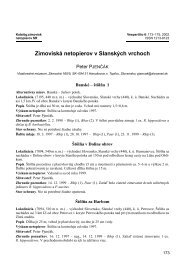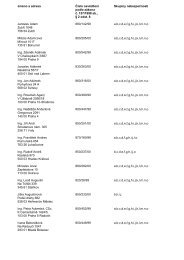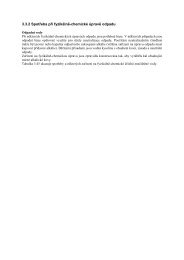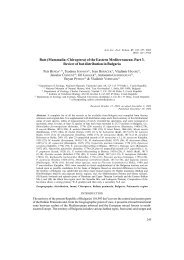character is less pronounced <strong>in</strong> Oligoaeschna Selys, 1889 (<strong>in</strong> o<strong>the</strong>r Gomphaeschna Selys, 1871species and Gomphaeschna miocenica sp. n., <strong>the</strong> most distal cross-ve<strong>in</strong> of this area is opposite<strong>the</strong> base of IR2, but <strong>the</strong>re is one more <strong>in</strong> a slightly distal position at least <strong>in</strong> Oligoaeschna pryeri(Mart<strong>in</strong>, 1909) and Oligoaeschna modigliani (Selys, 1889).With<strong>in</strong> this family, <strong>the</strong> autapomorphy of <strong>the</strong> fossil subfamily Gomphaeschnaoid<strong>in</strong>ae Bechly etal., 2001 that could be visible <strong>in</strong> G. miocenica sp. n. is absent <strong>in</strong> this taxon: its pterostigmal braceve<strong>in</strong> is not very oblique. The o<strong>the</strong>r autapomorphies of <strong>the</strong> Gomphaeschnaoid<strong>in</strong>ae are unknown <strong>in</strong>G. miocenica sp. n.: “only a s<strong>in</strong>gle secondary antenodal cross-ve<strong>in</strong> between Ax1 and Ax2 alignedlike a primary antenodal bracket” and “<strong>in</strong> forew<strong>in</strong>g, Ax2 shifted basally on level of basal angle ofdiscoidal triangle”. As G. miocenica sp. n. has a plesiomorphic state of character, it is not sufficientto exclude it from this subfamily. Also, <strong>the</strong> o<strong>the</strong>r subfamily “Gomphaeschn<strong>in</strong>ae” (sensu Bechly etal. 2001) has no known autapomorphy and could be paraphyletic. Never<strong>the</strong>less, G. miocenicasp. n. is very different from all Gomphaeschnaoid<strong>in</strong>i <strong>in</strong> its pterostigmal brace not undulat<strong>in</strong>g, <strong>the</strong>absence of any basally widened cell below pterostigma, its cross-ve<strong>in</strong>s between RP2 and RP1 allsimilar, not oblique. It also differs from <strong>the</strong> unique representative of <strong>the</strong> S<strong>in</strong>ojagor<strong>in</strong>i Bechly et al.,2001 (S<strong>in</strong>ojagoria Bechly et al., 2001) <strong>in</strong> its less numerous postnodal cross-ve<strong>in</strong>s and <strong>in</strong> <strong>the</strong> basalpart of area between RP2 and RP1 (6 aga<strong>in</strong>st 10–12). Lastly, it differs from <strong>the</strong> Lower CretaceousAnomalaeschna berndschusteri Bechly et al., 2001 <strong>in</strong> its dist<strong>in</strong>ctly longer pterostigma, cover<strong>in</strong>g 2cells <strong>in</strong>stead of only one.With<strong>in</strong> “Gomphaeschn<strong>in</strong>ae”, <strong>the</strong> recent genus L<strong>in</strong>aeschna Mart<strong>in</strong>, 1909 is very different fromG. miocenica sp. n. <strong>in</strong> its very long postnodal area with numerous cross-ve<strong>in</strong>s and its absence ofgap <strong>in</strong> <strong>the</strong> distal part of antesubnodal area (Mart<strong>in</strong> 1909). Bechly et al. (2001) considered that thisgenus could belong to a different family of <strong>the</strong> clade Aeshnoptera. The rema<strong>in</strong><strong>in</strong>g genera areGomphaeschna, Oligoaeschna, Alloaeschna Wighton et Wilson, 1986 and Cretalloaeschna Jarzembowskiet Nel, 1996.The Lower Cretaceous Cretalloaeschna differs from G. miocenica sp. n. <strong>in</strong> <strong>the</strong> follow<strong>in</strong>g characters:(1) presence of one row of cells between RP3/4 and MA, (2) a straight IR2, (3) only 2 rowsof cells between IR2 and RP2, (4) 4–5 rows of cells between RP2 and RP1, <strong>in</strong>stead of 3 <strong>in</strong> G.miocenica sp. n. (Bechly et al. 2001). These authors <strong>in</strong>dicated that character (1) could represent asynapomorphy of Cretalloaeschna with Gomphaeschna, Gomphaeschnoides Carle et Wighton,1990 (<strong>in</strong> Gomphaeschnaoid<strong>in</strong>i), and Alloaeschna, but some specimens attributed to Alloaeschnapaskapooensis Wighton et Wilson, 1986 have 2 rows of cells def<strong>in</strong><strong>in</strong>g a long zigzagged ve<strong>in</strong>between RP3/4 and MA. Thus, this character is at least not so important, if subject to <strong>in</strong>traspecificvariation.The Late Paleocene genus Alloaeschna (at least A. paskapooensis and maybe A. marklaeWighton et Wilson, 1986) shares <strong>the</strong> autapomorphies proposed by Bechly et al. (2001) for <strong>the</strong>Gomphaeschnaoid<strong>in</strong>i, i. e. “presence of a characteristic elongate distal paranal cell <strong>in</strong> h<strong>in</strong>dw<strong>in</strong>g,longer than wide, directly basal of <strong>the</strong> anal loop” (see Wighton & Wilson 1986: Figs 1–10). InOligoaeschna and Gomphaeschna, <strong>the</strong> correspond<strong>in</strong>g cell is quadrate or transverse, wider thanlong; “pterostigmal brace ve<strong>in</strong> somewhat undulat<strong>in</strong>g”; “basally widened cell bellow pterostigma,caused by a curvature of RP1 at pterostigmal brace”; “posterior branches of CuAa relativelyweakly def<strong>in</strong>ed <strong>in</strong> h<strong>in</strong>d w<strong>in</strong>g” (at least <strong>in</strong> some specimens of Alloaeschna paskapooensis). Thus,we propose to transfer Alloaeschna to this tribe, previously only known <strong>in</strong> Lower Cretaceous. Itwould be its most recent representative <strong>in</strong> Early Cenozoic. As noted above, <strong>the</strong> preserved correspond<strong>in</strong>gcharacters of pterostigmal region are different <strong>in</strong> Gomphaeschna miocenica sp. n.It is extremely difficult to separate <strong>the</strong> two genera Gomphaeschna and Oligoaeschna on <strong>the</strong>sole basis of <strong>the</strong> w<strong>in</strong>g venation characters. Madsen & Nel (1997) proposed to use <strong>the</strong> presence of147
only 1–2 Bq cross-ve<strong>in</strong>s <strong>in</strong> Gomphaeschna <strong>in</strong>stead of 3 <strong>in</strong> Oligoaeschna. Bechly et al. (2001: 197)attributed <strong>the</strong> two Cretaceous species ?Gomphaeschna <strong>in</strong>ferna Prityk<strong>in</strong>a, 1977 and ?G. sibiricaBechly et al., 2001 to <strong>the</strong> genus Gomphaeschna on <strong>the</strong> basis of “a reduced w<strong>in</strong>g venation withfewer rows of cells between <strong>the</strong> ma<strong>in</strong> ve<strong>in</strong>s, and a short pterostigma with only one or two cellsbeneath it.” G. miocenica sp. n. has 2 Bq cross-ve<strong>in</strong>s and a short pterostigma cover<strong>in</strong>g only 2 cells.Thus, we tentatively attribute it to Gomphaeschna ra<strong>the</strong>r than to Oligoaeschna.Gomphaeschna miocenica sp. n. differs from ?G. <strong>in</strong>ferna <strong>in</strong> its undulated IR2 and area betweenIR2 and RP2 not narrowed near w<strong>in</strong>g marg<strong>in</strong>, with 3 rows of cells, <strong>in</strong>stead of 2 <strong>in</strong> ?G. <strong>in</strong>ferna. G.miocenica sp. n. differs from ?G. sibirica <strong>in</strong> <strong>the</strong> presence of only 3 rows of cells between RP1 andRP2 along w<strong>in</strong>g marg<strong>in</strong>, <strong>in</strong>stead of 7. G. miocenica sp. n. differs from recent Gomphaeschnafurcillata (Say, 1839) <strong>in</strong> its longer pterostigma cover<strong>in</strong>g 2 cells, <strong>in</strong>stead of one cell and a half, <strong>the</strong>presence of 3 rows of cells between IR2 and RP2, <strong>in</strong>stead of 1–2 rows and its IR2 dist<strong>in</strong>ctlyundulated. G. miocenica sp. n. also differs from <strong>the</strong> two Paleocene/Eocene Gomphaeschna paleocenicaMadsen et Nel, 1997 and ?Gomphaeschna danica Madsen et Nel, 1997 <strong>in</strong> its IR2 undulated,<strong>in</strong>stead of be<strong>in</strong>g straight. Ano<strong>the</strong>r important difference with all species of Gomphaeschna is<strong>the</strong> particular w<strong>in</strong>g coloration of G. miocenica sp. n. All recent and fossil Gomphaeschna havehyal<strong>in</strong>e w<strong>in</strong>gs (maybe except ?G. sibirica only known after a fossil with no preserved coloration).PALAEOGEOGRAPHIC REMARKSRecent species of Oplonaeschna and Basiaeschna are North American. The fossil genus Oligaeschnais known from <strong>the</strong> Oligocene of France, USA and Siberia. This suggests a Holarctic distributionof <strong>the</strong> Oplonaeschn<strong>in</strong>ae but little is known about <strong>the</strong> Cenozoic record of Gondwanian Aeshnoptera.Recent species G. furcillata (Say, 1839) and G. antillope Hagen, 1874 are distributed <strong>in</strong> <strong>the</strong>North America (USA), fossil members are known from Lower Cretaceous (?G. <strong>in</strong>ferna – Baissa <strong>in</strong>Buryat <strong>Republic</strong>, Sibieria and ?G. sibirica – Chita region, Siberia, Russia) and Upper Paleocene/Lower Eocene (G. paleocenica, ?G. danica – Moclay <strong>in</strong> Denmark). O<strong>the</strong>r related genus Oligoaeschnais recently liv<strong>in</strong>g <strong>in</strong> South-east Asia and fossil representatives are known from UpperEocene: O. anglica Cockerel et Andrews, 1916 – Gurnet Bay, Isle of Wight, UK; Lower Oligocene:O. needhami (Cockerell, 1913) – Florissant, Colorado, USA, O. oligocenica (Nel et Papazian, 1983)– Aix-en-Provence, France, O. conjuncta (Martynov, 1929) – Ashutas Mounta<strong>in</strong>s, Zaisan, Siberia;Lower Miocene: ‘Projagoria conjuncta Martynov, 1929’ (sensu Zeuner 1938) – “Ma<strong>in</strong>zer Hydrobienkalks”,Germany, Oligoaschna s<strong>in</strong>ica (Zhang, 1989) comb. nov. – Miocene, Shanwang, Shandong,Ch<strong>in</strong>a, and Upper Pliocene: Oligoaeschna sp. (Esaki & Asah<strong>in</strong>a 1957, Nel et al. 1994) –Nagasaki Prefecture, Japan. The fossil genus Alloaeschna is known from Paleocene (A. paskapooensis,A. marklae W<strong>in</strong>gton et Wilson, 1986, A. quadrata Wighton et Wilson, 1986 – Blackfalds<strong>in</strong> Alberta, Canada). All o<strong>the</strong>r representatives of <strong>the</strong> Gomphaeschnaoid<strong>in</strong>ae are from <strong>the</strong> LowerCretaceous of Ch<strong>in</strong>a, Mongolia, UK and Brazil. From <strong>the</strong>se palaeogeographical data we can assumea very wide, maybe almost cosmopolitan distribution of <strong>the</strong> family dur<strong>in</strong>g <strong>the</strong> Lower Cretaceous,a wide Holarctic distribution of <strong>the</strong> subfamily Gomphaeschn<strong>in</strong>ae dur<strong>in</strong>g <strong>the</strong> Tertiary and amore marg<strong>in</strong>al occurrence of <strong>the</strong> taxa present today.A c k n o w l e d g e m e n t sThe authors are grateful to Zdenk Dvoák (Doly Bíl<strong>in</strong>a) and Kamil Zagoršek (National Museum Prague) for <strong>the</strong>loan of <strong>the</strong> material. The name of Kvacekia gen. n. is dedicated to 65 birthday of Prof. Zlatko Kvaek, leader of<strong>Czech</strong> palaeobotany at Charles University. The research was supported by grants of <strong>the</strong> M<strong>in</strong>istry of Schools J13/98-113100004, GAUK 197/2000 and GAR 205/01/0639.148
- Page 2:
Acta Soc. Zool. Bohem. 66: 81-84, 2
- Page 5 and 6:
REFERENCESBERAN L. & HORSÁK M. 199
- Page 7:
Tab. 1. Nematodes studied with the
- Page 10:
Tab. 2. The dimensions (mm) of thir
- Page 14 and 15:
Family Acuariidae Railliet, Henry e
- Page 16 and 17:
Fig. 7. Cosmocephalus obvelatus (Cr
- Page 18 and 19: A c k n o w l e d g e m e n t sThe
- Page 20 and 21: Acta Soc. Zool. Bohem. 66: 99-119,
- Page 22 and 23: Figs 1-10. Harpalus (Harpalus) atra
- Page 24 and 25: Figs 11-19. Harpalus (Harpalus) cis
- Page 26 and 27: Figs 20-27. Harpalus (Harpalus) lut
- Page 28 and 29: Figs 28-35. Harpalus (Harpalus) pic
- Page 30 and 31: Figs 36-44. Harpalus (Harpalus) sax
- Page 32 and 33: Figs 45-53. Harpalus (Harpalus) ser
- Page 34 and 35: Figs 54-61. Harpalus (Harpalus) sol
- Page 36 and 37: Figs 62-70. Harpalus (Harpalus) xan
- Page 38 and 39: Based on the study of our larval ma
- Page 40 and 41: EMDEN F. I. van 1942: A key to the
- Page 42 and 43: Acta Soc. Zool. Bohem. 66: 121-140,
- Page 44 and 45: and D. papillifera (Fuhrmann, 1908)
- Page 46 and 47: about 1 mm) with only a few eggs in
- Page 48 and 49: The number of catfish examined each
- Page 50 and 51: number (3.65) of trematodes with ma
- Page 52 and 53: cestode was distinctly associated w
- Page 54 and 55: from individual months. Tab. 2 show
- Page 56 and 57: number (5.57) of males occurred in
- Page 58 and 59: intermediate host, copepod, catfish
- Page 60 and 61: CHUBB J. C. 1982: Seasonal occurren
- Page 62 and 63: Acta Soc. Zool. Bohem. 66: 141-150,
- Page 64 and 65: efore distal angle of discoidal tri
- Page 66 and 67: cells between them and IR2 or MA”
- Page 70 and 71: REFERENCESBACHMAYER F. 1952: Fossil
- Page 72 and 73: Acta Soc. Zool. Bohem. 66: 151-160,
- Page 74 and 75: elow) and a 170×90×70 type was us
- Page 76 and 77: the brood, first into heaps near th
- Page 78 and 79: trophallaxis until the termination
- Page 80 and 81: 4. The queen that was accepted was








